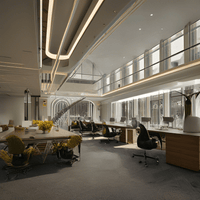What Kind of Lighting is Best for an Office?
Introduction
Whispered conversations, the gentle tapping of keyboards, and the soft hum of a host computer are all familiar sounds in an office environment. But there's another crucial, though silent, player influencing our workspace: lighting. The glow that illuminates our reports and casts shadows on our coffee cups doesn't just help us see; it shapes how we feel and perform. Understanding the profound impact of appropriate lighting on employee productivity and well-being is not just a matter of comfort—it's a strategic asset for any successful business.

Three Types of Office Lighting
1. Ambient Lighting
As the primary light source, ambient lighting is installed across ceilings to create broad, uniform illumination throughout entire office spaces. Typically, ambient lighting employs overhead LED panel troffers laying down a bright yet comfortable blanket of light across open work areas. By distributing an even glow, ambient light allows visibility for walking from room to room or discerning facial expressions during meetings without dark pockets or eye squinting. It establishes a flexible baseline of quality illumination.
2. Task Lighting
While ambient light washes over offices with a uniform glow, task lighting zeroes in on specific zones to intensely brighten individual workspaces. Mounted under shelves or clipped onto desks, task lights cast focused rays exactly where intricate work demands sharp visual attention. This supplemental illumination provides employees with the additional brightness necessary for managing visually intensive tasks on screens or paper, ensuring their work is free from shadows or glare.
3. Accent Lighting
Beyond simply illuminating office spaces, accent lighting infuses them with character and interest. Strategically positioned LED spotlights splash light across architectural features, modern art canvases, or branded signage on walls. Focused beams highlight office aesthetics, convey company values visually, and add depth through contrast - transforming bland areas into inspired environments. The possibilities span from accentuating an executive panorama to establishing corporate color themes tied to logos.
How to Select the Right Lighting for Different Office Areas?
1. General Offices
In open office floor plans, recessed LED troffer panels in suspended ceilings effectively distribute a bright yet comfortable ambient light across the entire space. Employees can clearly see documents on desks nearby or colleagues conversing several cubicles away without eyestrain. The consistent overhead lighting aids visibility whether teams are actively collaborating or individuals are focused solo on computer tasks.
2. Employee Workstations
At employee workstations, the uniform ambient illumination combines with desk clamp fixtures, positioning LED task lights directly over keyboards. By lighting documents and monitors without screen glare or shadows, task lighting helps sustain employee attention, visual comfort, and accuracy during long hours of computer-based work.
3. Conference Rooms
Inside sleek conference rooms, managers can tune state-of-the-art LED fixtures to emit anything from a vibrant 5000K downlight for engaging multimedia presentations to a subdued 3000K glow during relaxed yet candid budget meetings. With smooth dimming and color temperature tuning capabilities, the flexible lighting fosters diverse occasions.
4. Breakrooms
In employee breakrooms, wall-mounted strips diffuse a tranquil illumination perfect for unwinding over lunch. The warm white tone contrasts open work areas to help re-energize staff with a cozy, laid-back ambiance where they can comfortably refuel before returning to fast-paced productivity.
Energy Efficiency and Sustainability
Advancements in lighting technology beckon with promises of eco-friendliness and sleek design. LEDs stand out as the beacon of this revolution, offering substantial energy savings, an impressive lifespan that dwarfs traditional bulbs, and minimal maintenance hassles.
But the innovation doesn't stop at bulb selection. Implementing occupancy sensors means lights only illuminate when they detect motion, slashing unnecessary power usage in rarely used corners or after hours. Dimmers also play a pivotal role, giving control over light intensity setting the scene for both high-focus activities and relaxed conversations, all while conserving energy.
The most elegant office designs interlace the threads of artificial and natural light. Windows and skylights don’t just frame views; they invite rays of sunlight to dance across workspaces, reducing reliance on electric lighting and reconnecting us with the world outside.
Conclusion
Lighting in an office is a subtle symphony: each type of light is a set of notes that must harmonize perfectly. As we have traversed the landscape of office lighting, the importance of choosing wisely becomes clear—it's about balancing the practical with the pleasurable, the functional with the sustainable. A thoughtfully illuminated office transcends mere workspace; it becomes a dynamic environment that responds to the needs of its inhabitants and respects the pulse of the planet. Embracing this holistic approach to lighting design isn't just a bright idea for today; it's a shining path toward a future where work and wellness walk hand in hand, illuminated every step of the way.



